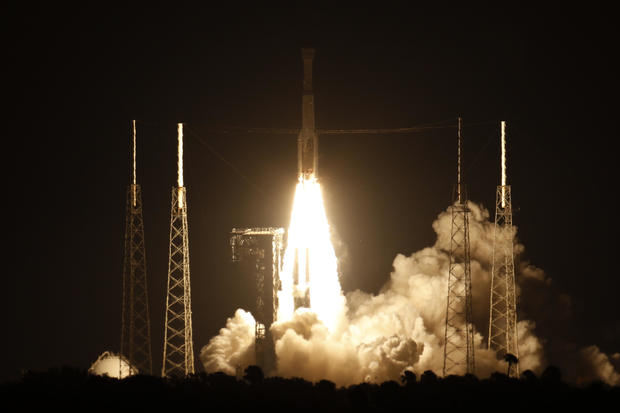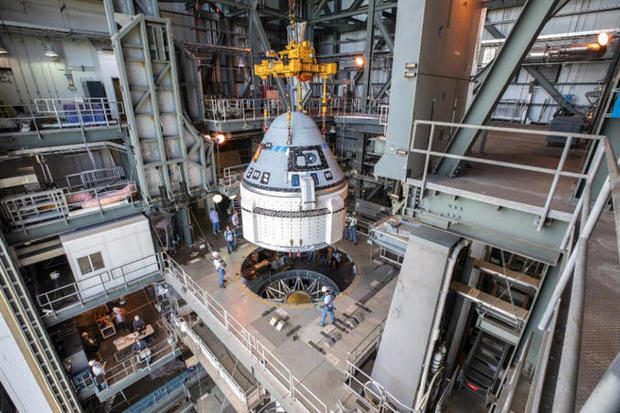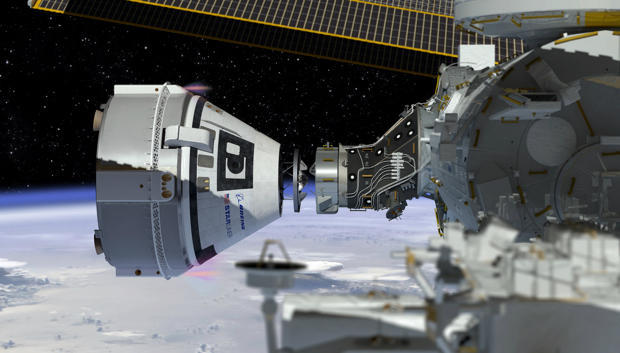A United Launch Alliance Atlas 5 rocket roared to life and shot away from Cape Canaveral early Friday, propelling Boeing's new Starliner capsule toward orbit for an unpiloted test flight to the International Space Station. The long-awaited mission sets the stage for the resumption of astronaut launches from U.S. soil in early 2020.
The workhorse Atlas 5's Russian-built RD-180 first stage engine fired up at 6:36 a.m. EST, followed by ignition of two solid-propellant strap-on boosters. The 172-foot-tall rocket then vaulted away from pad 41 at the Cape Canaveral Air Force Station atop nearly 1.6 million pounds of thrust.
Lighting up the pre-dawn sky with a brilliant jet of white-hot exhaust, the Atlas 5 quickly arced away to the northeast, putting on a spectacular morning sky show for spaceport workers, tourists and area residents along Florida's "Space Coast."
Trending News
If all goes well, the Starliner will catch up with the space station early Saturday. After a series of maneuvers to test the spacecraft's navigation, propulsion and control systems, the Starliner will move in for a docking at the station's forward port around 8:27 a.m.
The mission marks a major milestone in NASA's push to end the agency's post-shuttle eight-and-a-half-year reliance on Russian Soyuz spacecraft for transportation to and from the International Space Station at more than $80 million per seat.
It also marks a major step toward opening up low-Earth orbit for commercial development, including eventual flights by non-professional astronauts ranging from private-sector researchers to space tourists and even journalists.
"We're talking about technology development, we're talking about science, but we're also talking about folks that can capture the amazement of space," said NASA astronaut Nicole Mann, one of three crew members who will launch aboard a Starliner next year. "So maybe teachers, maybe journalists, maybe artists. ... Those possibilities are just beginning."
But first, Boeing and SpaceX, NASA's other commercial crew contractor, must complete their initial test flights and begin operational space station crew rotation missions. SpaceX completed a successful unpiloted test of its Crew Dragon capsule in March and Friday's launch marked Boeing's long-awaited turn at the plate.
Carrying an instrumented astronaut test dummy nicknamed "Rosie," the Starliner will deliver about 600 pounds of food, clothing and equipment to the station's six-member crew, along with holiday gifts.
The spacecraft will remain docked over the Christmas holiday, returning to Earth on Dec. 28 with a pre-dawn parachute and airbag-assisted landing at the White Sands Missile Range in New Mexico.
If all goes well, Boeing and SpaceX both will carry out initial piloted test flights to the station in the next several months, ending a hiatus in U.S. human space launch that began with the shuttle's final flight in 2011.
"We're moving into a new era, we are going to launch American astronauts on American rockets from American soil for the first time since the retirement of the shuttle, and we're going to do that in the first part of next year year," said NASA Administrator Jim Bridenstine.
"But we're doing it in a way that never been done before. This time, we're going to go with commercial partners. NASA is done purchasing, owning and operating the hardware. We're buying a service, the goal being that NASA wants to be one customer of many customers in a very robust commercial marketplace for human spaceflight."
While NASA's commercial crew program is primarily focused on space station transportation, Boeing and SpaceX are free to explore purely commercial missions carrying private citizens and researchers to the space station or commercial outposts that may one day be developed.
"Starliner is built to hold up to seven. It's currently configured for five and we have a deal with NASA for four of those seats," said Boeing Vice President Chris Ferguson. The former shuttle commander will join Mann and NASA astronaut Mike Fincke for the capsule's first piloted flight. "So clearly we have a lot of interest.
"Over time, safety will improve, costs will improve," he said. "And I really think that that is the long pole out there, can we bring the cost of an orbital flight down to the realm at which perhaps somebody that is of moderate means can do it? We probably are a few years away from that. But we won't get there until we start. And what we're going to see (Friday) is the start."
But it hasn't been easy. Or inexpensive.
Since the space shuttle's retirement in 2011, NASA has been forced to buy seats aboard Soyuz spacecraft to ferry U.S. and partner astronauts to and from the International Space Station. Seats on recent missions have cost more than $80 million each and since 2006, NASA has spent $3.9 billion for 70 Soyuz "tickets."
In 2014, after a series of competitions, NASA announced that Boeing and SpaceX would share $6.8 billion to develop independent space taxis, the first new U.S. crewed spacecraft since the 1970s.
Under a $2.6 billion contract, SpaceX is building a crewed version of its Dragon cargo ship that will ride into orbit atop the company's Falcon 9 rocket. Boeing's Starliner is being developed under a $4.2 billion contract and will rely on the Atlas 5 for launch.
Both companies are required to launch two test flights, one unpiloted and one with a crew. NASA originally expected those flights in 2017, but both companies have been delayed by funding shortfalls in Congress and by a series of technical issues, including trouble with parachutes and emergency abort systems.
Those delays forced NASA to buy additional Soyuz seats, at a cost of about $1 billion, to ensure an uninterrupted U.S. presence on the space station, according to the agency's inspector general.
After a successful unpiloted flight to the space station in March, SpaceX suffered a major setback in April when that same Crew Dragon capsule was destroyed during a ground test. The California rocket builder has recovered from that incident and is preparing for a dramatic in-flight abort test in early January.
If that test goes well, SpaceX will press ahead for launch of a Crew Dragon carrying two NASA astronauts — Douglas Hurley and Robert Behnken — on a piloted test flight to clear the way for operational crew rotation missions.
In a similar fashion, Boeing's unpiloted test flight this week is one of the company's final hurdles before it can launch Ferguson, Fincke and Mann on their own test flight.
It's not yet known which company will get a crew into orbit first, but SpaceX would appear to have the edge because the Atlas 5 has multiple launches on its early 2020 manifest, including a high-priority science mission in February followed by two military flights in March and April.
SpaceX operates two launch pads in Florida, giving it more scheduling flexibility. But multiple reviews will be required before either company is cleared to carry astronauts, and no launch date decisions have been made.
But NASA needs one or both companies to fly soon. The last currently-contracted seat aboard a Soyuz will be used by astronaut Chris Cassidy in April. After that, just one U.S. astronaut will be aboard the station until one or both commercial crew ships begin ferry service.
Hedging its bets, NASA managers are negotiating with the Russian space agency Roscosmos to buy two more seats to protect against the possibility of additional delays in NASA's commercial crew program. But no final decisions have been made.
https://news.google.com/__i/rss/rd/articles/CBMiaWh0dHBzOi8vd3d3LmNic25ld3MuY29tL25ld3MvYm9laW5nLXN0YXJsaW5lci1sYXVuY2gtd2F0Y2gtbGl2ZS1zdHJlYW0tbmFzYS10ZXN0LWZsaWdodC10b2RheS0yMDE5LTEyLTIwL9IBbWh0dHBzOi8vd3d3LmNic25ld3MuY29tL2FtcC9uZXdzL2JvZWluZy1zdGFybGluZXItbGF1bmNoLXdhdGNoLWxpdmUtc3RyZWFtLW5hc2EtdGVzdC1mbGlnaHQtdG9kYXktMjAxOS0xMi0yMC8?oc=5
2019-12-20 11:44:00Z
52780505444912



Tidak ada komentar:
Posting Komentar